Chapter 5 Light Reflection Of Light A Spherical Mirror Spherical Surface As A Reflector Of Light
We have learned the nature of the images formed by a plane-reflecting surface such as a plane (flat) mirror.
However, mirrors can be curved also, like steel shining spoons, bowls, dishes, torches, view-finder of cars, street lamps, etc.
These curved surfaces have different shape-spherical, parabolic elliptical, etc. Curved surfaces can form images of different nature than a plane mirror.

Let us take a shining stainless spoon and view our face very close to its curved inner surface. We will see an erect (upright) and enlarged image of our face.
If the spoon is moved away from the face, an inverted diminished image can be seen in the spoon.
WBBSE Notes For Class 10 Physical Science And Environment
Now, if the curved outer surface of the spoon is brought near the face, an erect but diminished image is seen in the spoon.
If the spoon is moved away from the face, the image still remains erect but diminished. Here spoons, bowls, etc. are only approximately spherical surfaces.
in this example, the curved inner surface (i.e., cave side) of the spoon acts as a concave mirror and the curved outer surface (i.e., bulging side) acts as a convex mirror.
Wbbse Class 10 Physical Science Notes
The idea of a Spherical Mirror: These are collectively called spherical mirrors because they are made by cutting from a sphere.
Spherical mirrors are mainly of two types:
- Concave mirror and
- Convex mirror.
A concave mirror is made by silvering the outer or bulging surface of a hollow sphere such that the reflection of light takes place at the concave, i.e., bent-in-surface.
A convex mirror is made by silvering the inner surface of a hollow sphere such that the reflection of light takes place at the convex, i.e., bulging-out surface.

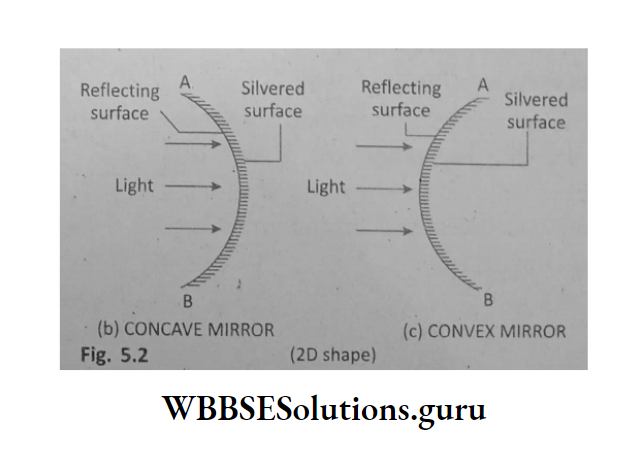
Chapter 5 Light Geometry Of Spherical Mirror
1. Pole The geometric mid-point of the reflecting surface of a spherical mirror is called its pole. P is the pole.
2. Centre of curvature: The geometric center of the hollow sphere of which the spherical mirror is cut, is called its center of curvature. it is denoted by C.
Wbbse Class 10 Physical Science Notes
3. Radius of curvature: The radius of the hollow sphere of which the spherical mirror is cut, is called the radius of curvature of the mirror. length PC (= R) is the radius of curvature.

In a concave mirror, C is in front of the reflecting surface, and in a convex mirror C is inside the reflecting surface.
4. Principal axis: The straight line joining the center of curvature C and pole P of a spherical mirror is called its principal axis. the line PC represents the principal axis.
5. Aperture: The effective part of the spherical mirror from which the reflection of light occurs is called its aperture. AB is the aperture of the spherical mirror.
Wbbse Class 10 Physical Science Notes
For most of the cases of our present study, we take spherical mirrors with a very small aperture.
Chapter 5 Light Reflection In Spherical Mirror
We got the knowledge of the laws of reflection for plane surfaces in classes VII and VIII. The laws are:
The incident ray, the reflected ray, and the normal lie in the same plane (on the plane of paper at the point of incidence).
The angle of incidence, <i = angle of reflection, <r (Always true).
The same laws of reflection are used for drawing ray diagrams in the case of spherical mirrors to know the position, nature, and size of the image formed by a spherical mirror.

1. Drawing of normal for a spherical mirror: For a curved reflecting surface, the normal always passes through the center of the surface because we know that for an arc, the radius drawn at any point is perpendicular to the tangent drawn at that point.
We can draw the normal at the point of incidence of the spherical mirror by joining point ‘C with the point of incidence
Since for normal incidence <i = 0 and <r = 0, a ray of light passing through or towards the center of curvature gets reflected back along the same path without any deviation in a concave mirror and appears to pass through the center of curvature in a convex mirror.
Wbbse Class 10 Physical Science Notes
2. Drawing of the incident ray and reflected ray: A ray of light incident at any point of a spherical surface is reflected such that at the point of incidence <i = <r.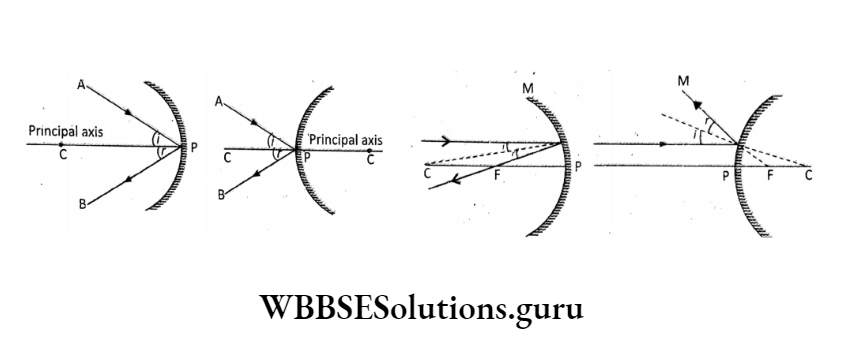
A ray of light incident obliquely at P is for a concave mirror and for a convex mirror.
For a ray of light incident parallel to the principal axis of a concave mirror after reflection meets at a point on the principal axis and the same ray after being reflected by a convex mirror diverges or appears to come from a point on the principal axis.
Drawing of many incident rays: For a set of rays incident parallel to the principal axis of a spherical mirror, the ray diagram.
For a set of convergent rays incident on a concave mirror after reflection meets at a point I (in front of a mirror) for which point 0 acts as a virtual object.
Similarly, convergent rays directed towards point O such that PO < PF after reflection by a convex mirror appear to come from the point I. Here I behave as a real image of virtual point object O;
However, divergent rays coming from a point object on the principal axis after being reflected by a concave mirror converge at a point (point image).
Here one point is to be noted that after reflection whether the rays would converge or diverge depends on the position of a point object.
The divergent rays from a point object on the principal axis of a convex mirror, after reflection, diverge more and appear to come from a point inside the mirror.
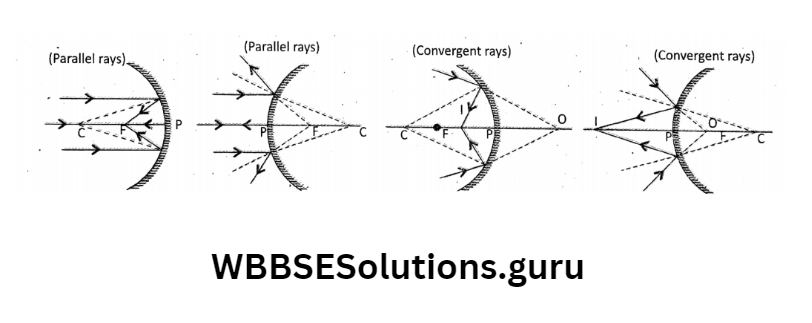
4. Concept of focus and focal length: Principal focus (or focus) is a point on the principal axis at which a beam of light rays parallel to the principal axis, after reflection, actually meets (in the case of a concave mirror) or appears to meet (in case of a convex mirror).
point F refers to the focus of the mirror. A concave mirror F lies in front of the mirror- it is a real point. shows that a convex mirror has a virtual or imaginary focus as it lies behind the mirror.

A concave mirror is called a converging mirror, as all the light rays parallel to the principal axis, after reflection, converge to a point in front of the mirror.
A convex mirror is called a diverging mirror, as all the rays parallel to the principal axis, after reflection, appear to come from a point Situated behind the mirror.
A ray of light passes through F of a concave mirror after reflection becomes parallel to the principal axis, and for a convex mirror a light ray directed towards F after reflection goes parallel to the principal axis according to the reversibility of light.
Focal length: The distance from pole (P) to focus (F) of a spherical mirror is called its focal length. It is denoted as f. Thus, focal length f= PF.
Wbbse Class 10 Physical Science Notes
It is found for a mirror of a very small aperture that point F lies exactly midway between points P and C. That is, focal length \((f)=\frac{\text { radius of curvature }(r)}{2}\)

Focal plane: Sets of parallel rays of light after reflection from a concave mirror meet at a point (F’) which always lies in a plane passing through F perpendicular to the principal axis and for a convex mirror sets of parallel rays after reflection diverge.
The divergent rays on being produced backward meet at a common point which lies in a plane passing through F perpendicular to the principal axis.
This plane is called the focal plane. Thus, an imaginary plane passing through the focus and normal to the principal axis of a spherical mirror is called the focal plane of the mirror.
A parallel beam of light rays inclined to the principal axis is focussed at a point in this plane.
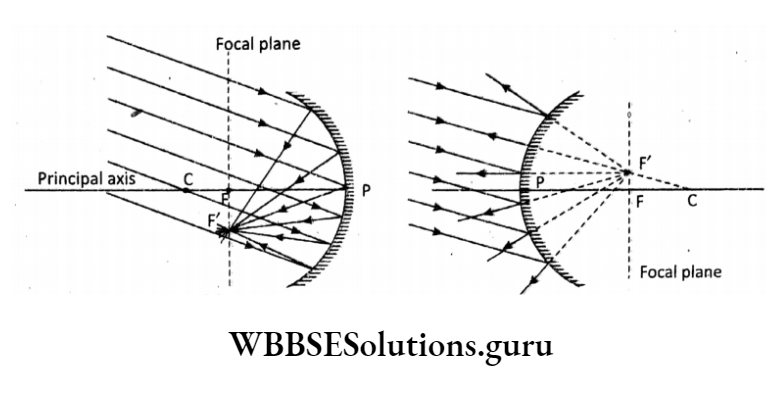
Activity: Estimation of the focal length of a concave mirror: This can be done with the help of the principle that a parallel beam of light after reflection by a concave mirror meets at a point in the focal plane.
A concave mirror is held facing the window and a plane of white paper (acts as a screen) is kept in front of it.
The position of the mirror is so adjusted to cast a distinct image of the window on the paper.
Measuring the length of the paper from the position of the mirror by a scale, an approximate value of the focal length of the mirror can be obtained.

Chapter 5 Light Mechanism Of Image Formation By Ray Diagram
To draw a ray diagram for image formation by a spherical mirror, we are to consider at least any two convenient reflected light rays,
Following the rules:
Rule: 1. A ray of light traveling parallel to the principal axis, after reflection by a concave mirror, passes through its focus (F); and in the case of a convex mirror, the reflected ray appears to be coming from the focus of the mirror.

For image formation, we need at least two rays and find out either the point of intersection or the point of emergence.

Rule: 2. A ray of light passing through the principal focus (F) of a concave mirror is reflected parallel to its principal axis; and in the case of a convex mirror, a ray of light traveling towards its principal focus, after reflection, becomes parallel to its principal axis.

Rule: 3. A ray of light passing through or towards the center of curvature (C) of a concave and convex mirror respectively, is reflected back along the same path without any deviation.
The idea of Paraxial rays: A beam of light rays, which are parallel and very close to the principal axis, are considered paraxial rays.

For example, rays AB, and DE These rays are taken into account in defining the F of a spherical mirror.
Rays away from the principal axis (GH, KL) are called marginal rays. After reflection, they also converge but do not meet the principal axis at point F.

To show r = 2f for paraxial rays: For a concave mirror: P, F, and C are the pole, focus, and center of curvature of a concave mirror.
PC = radius of curvature, r, and PF = focal length,f. Here < BDC = < DCF (alternate angles) and <BDC = < CDF (by < i = < r relation) < DCF = < CDF Hence, <FDC is isosceles.
That is, DF = FC. For a mirror with a very small aperture, D is very close to P. Then DF=FC.
therefore Pf=Fc \(\text { or, } P F=\frac{1}{2} \cdot P C \text { or, } f=\frac{1}{2} r\)
2. For a convex mirror: P, F, and C are the pole, focus, and center of curvature of a convex mirror. PC = radius of curvature, r, and PF = focal length, f.
Here <BDN = <FCD (corresponding angles ; as BD 11 PC, DC the transversal) <BDN = <NDR (by <i = <r relation) and <NDR = <CDF (vertically opposite angles) <FCD = <CDF
Hence, <FDC is isosceles. That is, DF = FC. For a mirror with a very small aperture, D is very close to P. Then DF — PF, therefore, Pf=Fc \(\text { or, } P F=\frac{1}{2} \cdot P C \text { or, } f=\frac{1}{2} r\)

Locating the image formed by a concave mirror by drawing a ray diagram: We can study the nature, position, and size of the image formed by a concave mirror for a point object or extended object placed in front of the mirror.
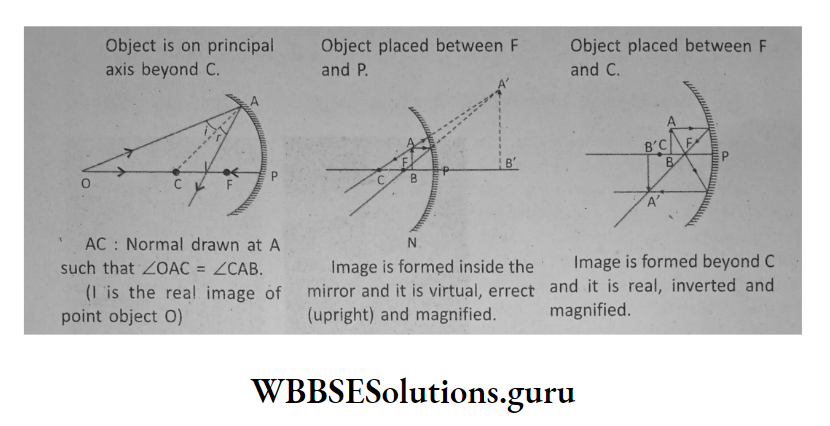
Chapter 5 Light Uses Of Spherical Mirrors
Dentists use concave mirrors of a large focal length (f) or a large radius of curvature (r) so that an erect and magnified image of our tooth can be seen inside the dentist’s mirror.
Large/means teeth come within the focal length easily. For the same reason, ENT specialists also use concave mirrors.
A concave mirror held near the face always produces an upright and enlarged image between its pole and focus, whereas a plane mirror produces an upright and of the same size image of the face.
Dentist mirror So that the face can be viewed more prominent by a concave mirror. Due to p this fact, a concave mirror is used as a shaving mirror.
Concave mirrors are also used in beauty parlors as make-up mirrors.
A car driver uses a convex mirror as a rearview mirror. A convex mirror diverges the incident light rays and always forms a virtual, erect, and small-in-size image between its pole and focus.
This enables the car driver to see all the traffic approaching from behind. The convex mirror also provides a wider field of view than a plane mirror or a concave mirror. This is the reason why the convex mirror is used as a ‘rear view mirror’.
In the headlight of automobiles, torches, etc. a parabolic metallic mirror is used.
The reason is that the parabolic reflecting surface produces a parallel beam of light for the light rays incident from the bulb which is situated at the focus of the concave surface. This enables car drivers to see objects situated far behind.
Chapter 5 Light Refraction Of Light What Happens When Light Travels From One Optical Medium To Another?
In earlier classes, we learned that light travels in a straight line through the same homogeneous medium having the same optical density throughout and its speed doesn’t change.
But when light travels from one homogeneous optical medium to another homogeneous medium, for example, from air to glass, air to water, the path of light bends as soon as it enters into the medium.
That is, the path along which light travels in the second medium is different from the path along which it was passing obliquely in the first medium.
Such a change in direction or bending of light is called refraction of light. It has been found experimentally that there is no change in direction of light when it passes normally.
Definition: The bending of light rays when it is passing obliquely from one transparent homogeneous medium to another transparent medium with different optical densities is called refraction of light.
Chapter 5 Light Laws Of Refraction
Refraction Of Light Obeys Two Important Laws These Are:
The incident ray, the refracted ray, and the normal drawn at the point of incidence of two separating media, all lie in the same plane.
For a definite color of light, and for a given pair of media, the ratio of the sine of the angle of incidence, to the sine of the angle of refraction is always a constant.
That is, \(\frac{\sin i}{\sin r}=a \text { constant }(\mu)\) This constant is called the refractive index of the second medium sin (where the light goes after refraction) with respect to the first medium (from where light is incident). This law is also called Snell’s law after the name of the scientist.
Explanation of Snell’s law: We know for the reflection of light at any surface ‘<i = <r’ is always true.
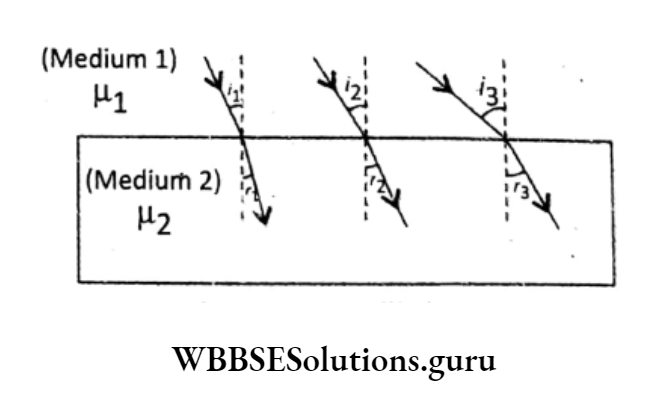
If we know the value of <i (30° or 40°), we can find the value of <r very easily and vice-versa. Similarly, for refraction of light if </ is given, the value of the angle of refraction <r can be found out using Snell’s law. Snell calculated that
\(\frac{\sin i}{\sin r}=\text { always a constant }=\mu\) example, referring to (ir , r1), (i2, r2), (i3, r3) are different sets of the angle of incidence and angle of refraction. For a given pair of media (here medium 1 and 2) and for a definite color (or wavelength λ).
\(\frac{\sin i_1}{\sin r_1}=\frac{\sin i_2}{\sin r_2}=\frac{\sin i_3}{\sin r_3}={ }_1 \mu_2=\frac{\mu_2}{\mu_1},\) , whatever the values of (i1, r1), (i1, r2), (i3, r3). (Here 1μ2→ r.i of medium 2 w.r.t medium 1)
Hence, from Snell’s law: \(\frac{\sin i}{\sin r}={ }_1 \mu_2=\frac{\mu_2}{\mu_1} \Rightarrow \mu_1 \sin i=\mu_2 \sin r\)
For normal incidence (<i= 0°): The relation p =\(\mu=\frac{\sin i}{\sin r}\)does not hold.
According to Snell’s law:\(\mu \cdot \sin r=\sin 0^{\circ}=0\) As refractive index \(\mu \neq 0\) so that sin r = 0 ⇒ r = 0°. Thus, if i = 0°, then r – 0°, and also the deviation of the ray δ = 0.
Significance of refractive index (r.i. or μ): A medium either optically rarer or denser is measured in terms of its μ of a medium is defined as, \(\mu=\frac{c}{v}=\frac{\text { Speed of light in air or vacuum }}{\text { Speed of light in that medium }} \text {. }\)
It’s a unitless/dimensionless quantity, simply a number, p is a. number that tells us how many times the speed of light is lesser in a medium than in air. For example
1. \(\mu_{\text {glass }}=1.5 \text { means }\) \(1 \cdot 5=\frac{c}{v} \Rightarrow V=\frac{c}{1 \cdot 5}\)
speed of light in glass is 1-5 times lesser than the speed of light in air
2. \(\mu_{\text {water }}\)=1.33 The speed of light in water is 1-33 times lesser than the speed of light in air.
3. \(\mu_{\text {diamond }}=2.42\)means the speed of light in diamond is 2-42 times lesser than the speed of light in air.
Here we see that
(1) larger μ means→ lesser v → optically denser medium and smaller p
mean→ more v → optically rarer medium.
(2) In the relation\(\mu=\frac{c}{v},\). of a medium is compared w.r.t. the r.i. of air. That’s why μ is called the absolute r.i. of the medium.
(3) In relation \(\mu=\frac{c}{v}\) value of c is always greater than v. That’s why μ>1, never μ<1.
(4) As c is constant, so μ depends on v only. reason for the bending of light is the difference in speed of light in different media.
Chapter 5 Light Angular Deviation Of Light Ray During Refraction
1. Two cases when light bends: When a ray of light passes from one medium to another, its speed is changed for which refraction of light takes place.
Referring we can say that if the medium doesn’t change then the light would travel in a glass along the dotted line, and due to the medium change light travels in glass through the thick line.
So, when light travels from a rarer medium to a denser medium, it bends towards the normal as i>r.
The deviation of the ray is 5 = (i ~ r). Similarly, while going from a denser medium to a rarer medium, light is bent away from the normal.
Thus, when light travels from a denser medium to a rarer medium it bends away from the normal. the deviation of the ray is, 5 = (r – i), as r > i.

Two cases when light doesn’t bend: For normal incidence: <i= 0°, and <r = 0°. Here, the speed of light changes, although its direction does not change.
That is light, passes without deviation. If the refractive indices of two media are the same, then a ray of light will pass from one medium to another without any change in the direction of its path.
Because the speed of light will be almost the same in both of the media. For example, a crown glass rod immersed in glycerine can not be seen separately \(\text { (as } \left.\mu_{\text {crown glass }} \approx \mu_{\text {glycerine }}\right)\)

Chapter 5 Light Structure Of A Glass Slab And A Prism
Glass slab: In ABCD is a rectangular slab (made of transparent glass or plastic) of the same thickness. It is put in the air.
So, air is a rarer medium, and glass (or plastic) is a denser medium. The slab has two refracting surfaces, AB and CD, of the same thickness.
A ray of light PQ falls on the upper surface (AB) in the air and refracts into the glass along QR.
At the lower surface (CD), the ray QR suffers another refraction at point R and emerges out along RS.
For refraction at point Q: PQ → incident ray, QR → refracted ray, and for refraction at point R: QR incident ray, RS → refracted (emergent) ray.
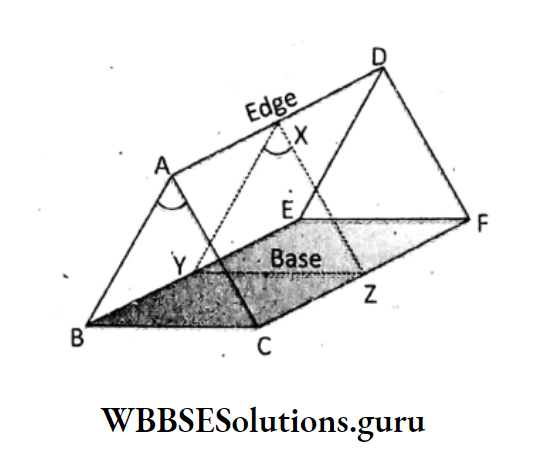
Prism: A prism is a piece of transparent homogeneous refracting medium bounded by three rectangular surfaces inclined at an angle and two triangular cross-sections. ABED and ACFD indicate two refracting surfaces, AD the refracting edge, and BCFE the base of the prism.
The two refracting surfaces make an angle (<YXZ) with each other and it is called the refracting angle or prism angle. In the prism the surfaces ABC and DEF are triangular.
The principal section (XYZ) is an imaginary triangle formed by the three refracting surfaces of the prism.
Chapter 5 Refraction Through A Glass Slab
A rectangular glass slab PQRS of thickness t. It has two refracting surfaces PQ and RS, parallel to each other.
A ray of light AO falls from the air on the surface PQ at the point of incidence 0 and suffers refraction inside the glass in a straight path along OB.
At point B, on the surface SR, it again suffers refraction and emerges out among BC in the air.
So, refraction takes place at O, from rarer to denser medium, and at B, from denser to rarer medium.
Let at point O, angle of incidence = I, angle of refraction = r, and at point B, angle of incidence = r (v alternate angle), angle of refraction = e (it is the angle of emergence).
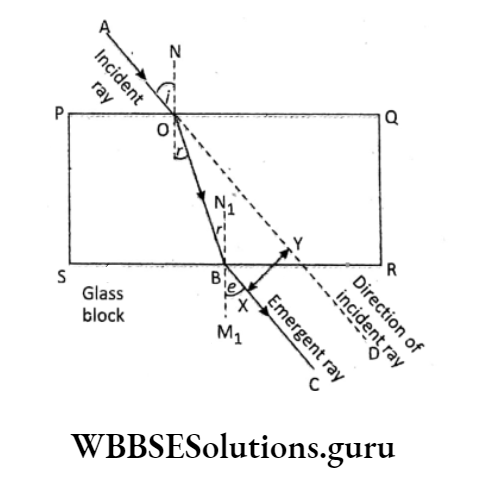
According to Snell’s law, for refraction at point O:
1. \(\frac{\sin i}{\sin r}=\mu\) (refractive index of glass with respect to air) And, For Refraction at point B:
2. \(\frac{\sin r}{\sin e}=\frac{1}{\mu}\) ( refractive index of air with respect to glass comparing these two, we get, \(\begin{aligned}
& \frac{\sin i}{\sin r}=\frac{\sin e}{\sin r} \Rightarrow \sin i=\sin e \\
& \Rightarrow i=e \Rightarrow \mathrm{AO} \| \mathrm{BC}
\end{aligned}\)
This means that the emergent ray BC is parallel to the incident ray AO i.e., they are in the same direction.
Thus, the light ray suffers no angular deviation, but only lateral displacement occurs. Here, XY is the measure of lateral displacement.
Lateral displacement: In the case of refraction of light through a rectangular glass slab, the perpendicular distance drawn between the emergent ray and the incident ray is called lateral displacement.
Refraction through a prism: Let ABC is the principal section of a prism with prism angle <BAC = A. On refracting face AB of the prism, in rarer medium OP is the incident ray and PQ is the refracted ray in the denser medium.
The angle of incidence is i1 and the angle of refraction is r1; and on refracting face AC of the prism, the respective angles are r2 and i2.
<p Thus, QR is the emergent ray and i2 is the angle of emergence, <LMQ is the measure of the angle through which the emergent ray deviated from the incident ray and is called the angle of deviation. It has a value of δ = i1 + i2 – A.
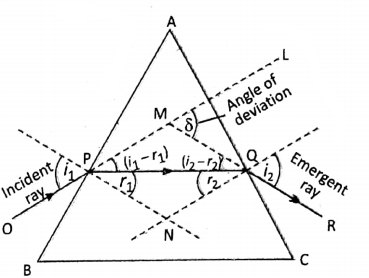
Derivation of δ using Simple Geometry: From ΔPMQ, external <LMQ = <MPQ+<MQP………(1)
Since < MPQ-Angle deviation at point p= (i1 – r2) and
<MQP = angular deviation at point Q=(i1 -r2) .
Thus, δ = (i1,-r1) + (i2-r2) = i1 + i2 – (r1+r2)………… (2)
Also for the quadrilateral APNQ, <A + <APN + <N+<AQN=360° ⇒ <A+90° +<N+ 90° =360° Thus, A+<N=180°……….(3),
Again For the Δ PNQ: ( r1+r2)+<N=180°…………….(4)
Comparing Equations (3) and (4): A= r1+ r2 …………(5)
Hence from Equations (2) and (5): δ= i1+ i2 -A………..(6)
i-δ graph: i-δ graph for the refraction of light through a prism The i-δ graph explains that as the angle of incidence
1. increases, the angle of deviation (δ) first decreases and reaches a minimum value for a particular value of i. By further increasing I, the value of δ also increases. This minimum value of δ is δmin.
It can be proved that the angle of deviation becomes minimum (δmin) under the condition: i1= i2 i.e., angle of Incidence = angle of emergence; And also r1 = r2.

The position of the prism with respect to the incident ray, at which the incident ray suffers minimum deviation is called the position of minimum deviation of the prism. At this position, i2 = i2 and also r1 = r2.
Chapter 5 Light Structure Of Spherical Lenses
A lens is a piece of transparent refracting medium (like glass, quartz, or transparent plastic) bounded by two spherical or one spherical and one plane surface.
We see various uses of lenses in cameras, spectacles, microscopes, telescopes, and in other optical instruments.
Out of two boundary surfaces, one must be spherical. For most of the lenses, we see both surfaces are spherical.
Types of lenses: Lenses are broadly classified into two types:
- Convex or converging lens, and
- Concave or diverging lens.
A convex lens is thick in the middle and thin at the edges. It converges parallel rays of light incident on it. A concave lens is thick at the edges and thin in the middle. It diverges parallel rays incident on it.
Further classification of lenses: Different types of convex lenses:
- A convex lens is of three types, such as
- bi-convex or equi-convex lens,
- plano-convex lens and
- concavo-convex lens. shows their shapes of them. Here first part (bi, piano, concave Indicates ‘shape’ &, last part (convex) indicates the ‘nature’ of the lens.
An equal-convex lens has both of its surfaces convex; a plano-convex lens has one surface plane and the other surface convex; and a concavo-convex lens has one surface convex and the other surface concave.
For all types, the lens is thicker in the middle and thinner at the edges. The net nature of all three lenses is like a convex lens i.e. converging light rays;
Different types of concave lenses:
- A concave lens is of three types, such as
- equi-concave lens,
- Plano concave lens, and
- convexo-concave lens.
The shapes An equi concave lens has both its surfaces concave; a plano concave lens has one surface plane and the other surface concave; and a convexo-concave lens has one surface concave and the other surface convex.
For all types, the lens is thinner in the middle and thicker at the edges. The net nature of all three lenses is like a Concave lens i.e. they diverge light rays.

Terms related to a lens:
Centre of curvature: Each surface of a lens is part of a sphere. The centers of two spheres are called the centers of curvature of those surfaces of the lens.
C1 and C2 are the centers of curvature of surfaces 1 and 2 respectively.
Principal axis: The line joining the two centers of curvature of two spherical surfaces of a lens is called its curved principal axis. In C1C2 is the principal axis.
For a lens having one plane surface, the position of the center of curvature is at infinity.
The radius of curvature: The radius of the sphere of which the lens is a part is called the
radius of curvature of the lens.
For an equi-convex or equi-concave lens, the radii of curvature of two surfaces are equal. If the thickness of a lens radius of curvature is, it is considered a thin lens.
Chapter 5 Light Refraction Through A Lens
The optical center of a lens: For a thin lens, the thickness is so small that it is negligible. But for a thick lens, thickness is to be taken into account.
For a thick lens, the ray incident on the lens and the emergent ray from the lens does not lie on the same line.
So, there occurs lateral displacement of the emergent ray Actually light deviates from its own path. The optical center for a thick lens is a fixed point on the principal axis.
An oblique ray of light incident at one curved surface of the lens emerges parallel to the incident ray.
The path of the ray within the lens intersects the principal axis at a fixed point, called the optical center. It is equidistant from the two curved surfaces of the lens.
PQ →incident ray and RS →the refracted ray. They are parallel to each other. The passage of the ray through the lens (here QR) touches the principal axis at O. Here, O is the optical center.

The optical center of a thin lens: It is a point on the principal axis of a thin lens through which a ray of light passes undeviated and undisplaced. The role of the optical center is similar like
the pole of a spherical mirror illustrates the optical center (O) for both convex and concave lenses.
Converging action of a convex lens: A convex lens may be considered a combination
of a number of prisms such that the prisms in the upper and lower halves have their bases downward towards the principal axis, while the central portion of the lens is just like a glass slab.
We know that the rays of light on passing through a prism, tend to deviate towards its base.
The light ray incident parallel to the principal axis after refraction by a small prism deviates towards the base of the prism, whereas the rays passing through the central portion deviate through lesser angles.
Thus, all the rays after refraction converge or meet at one point (called the focus points). This explains the converging action of a convex lens.
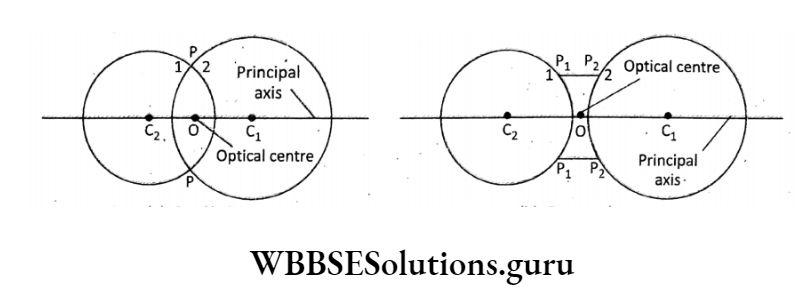
Diverging action of a concave lens: A concave lens may be considered as a combination of a number of prisms such that the prisms in the upper and lower halves have their bases towards the edges.
As we know that the rays of light passing through a prism, tend to deviate toward its base.
The ray incident parallel to the principal axis after refraction by a small prism deviates maximum towards the base of the prism whereas the light ray passing through the central portion deviates through lesser angles.
Thus, all the rays after refraction diverge or appear to come from a point (called the focus point). This explains the diverging action of a concave lens. Focus, focal plane, and focal length.

Chapter 5 Light Focus Focal Plane And Focal Length
A spherical mirror has one principal focus, but a lens has two principal foci. Because a spherical mirror has only one spherical reflecting surface, whereas a lens has two refracting surfaces.
The two principal foci of a lens (F1 and F2) are equidistant from the optical center, (focal length). In
In such that OF1 = OF2 = f our syllabus, we will study only thin lines which are sometimes represented by a straight line. First focus (not so much important in the discussion of the lens)

Definition: First focus (F1) of a convex lens is a point on the principal axis such that the rays of light coming from this point after refraction become parallel to the principal axis. If an object is kept at an F2 then the image is formed at infinity.
The first principal focus (F1) of a concave lens is a point on the principal axis such that the rays of light coming towards this point after refraction becomes parallel to the principal axis.
(F2) Second focus or Principal focus ‘focus’ means ‘second focus’ is lens discussion and is important)
Definition: Rays of light coming parallel to the principal axis of a convex lens after refraction become convergent to a common point (F2) on the principal axis. This common point is called the principal focus of the convex lens.

Rays of light coming parallel to the principal axis of a concave lens after refraction diverge.
The divergent rays being produced backward appear to come from a common point (F2) on the principal axis. This common point is called the principal focus of the concave lens.
Focal length: The distance of the principal focus of a lens from its optical center is called its focal length. OF2 = f is the focal length.
Focal plane: (a), parallel rays of light incident on a convex lens after refraction converges to common points such common points lie on a plane perpendicular to the principal axis.
For a concave lens, parallel light rays diverge from common points which also lie on a plane perpendicular to the principal axis.
This plane is called the focal plane. For a lens, the position of the focal plane is fixed.
Definition: A plane passing through the focus and normal to the principal axis of a lens is called the focal plane.
- The focal length of a lens depends on the
- The refractive index of the material of the lens,
- The radii of curvature of two spherical surfaces, and
- The color of light.
If the refractive index of the surrounding medium is more than that of the lens medium, then a convex lens behaves like a concave lens, and a concave lens behaves like a convex lens.
For example, an air bubble in water behaves like a concave lens (refractive index: μwater >μair ).

Chapter 5 Light Image Formation By A Thin Lens Using Ray Diagrams
To draw the ray diagrams of image formation by a convex or concave lens, we are to choose any two rays out of the three rays Here O is the optical center and F1 and F2 respectively are the first and second principal focus of the lens.
Generally, when we say focus, we mean F2 i.e., second principal focus. Both F1 and F2 are at the same distance from O, i.e., OF1 = OF2 = f (focal length of the lens).

Rules for drawing ray diagrams: –
A ray of light through the optical center of a convex or concave lens passes un-deviated
A ray of light incident parallel to the principal axis of a convex lens after refraction passes through the second principal focus (F2), and for a concave lens, the ray appears to come from the second principal focus (F2)
A ray of light passing through or directed towards the first principal focus (F2) after refraction passes through the principal axis In the following ray diagrams: AB → extended object kept normal to the principal axis; AB→ image formed. F1 → first focus, F2→ second or principal focus.
Formation of real, inverted, diminished image:
The object is kept beyond 2F1 (in between infinity & 2F1 ). Image is formed between F2 and 2F2. The image is real and inverted and diminished.

Formation of real, inverted, magnified image:
An object is kept between 2F2 and F1 Image is formed beyond 2F2. The image is real & inverted and magnified.
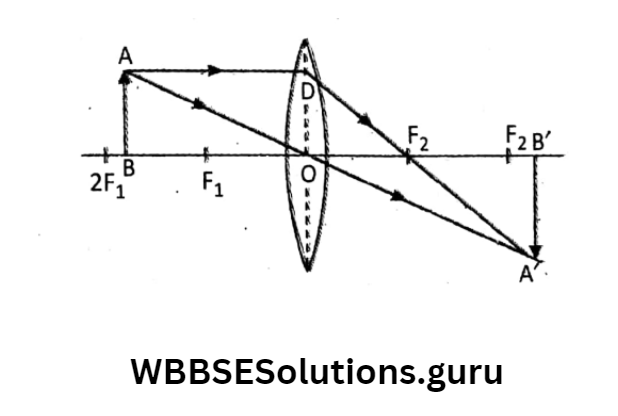
Formation of virtual, erect, and magnified images: The object is kept between F1 and O. The image is formed on the same side as that of the object.
The image is virtual, erect (upright), and magnified. This case is unique because it is the only case in which a convex lens produces a virtual image.

Geometric construction of images in the concave lens:
Generally, a concave lens always forms a diminished image (for objects kept at any point except infinity). Because it diverges all the light rays incident on it.
The rays after refraction do not intersect but they appear to come from the points between A’ and B’ as The image is formed on the same side of an object between O and F2.
It is virtual and upright and diminished.
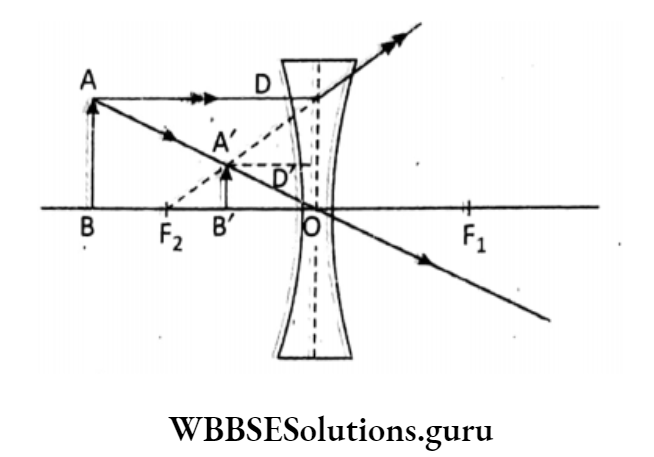
Linear magnification of image: Flow many times the height of the image is greater or smaller than the height of an object is expressed in terms of magnification. It is expressed as the ratio of image height to object height.
Thus, linear magnification (m) = \(\begin{aligned}
& =\frac{\text { Image height }(I)}{\text { Object height }(\mathrm{O})} \\
& =\frac{\text { Image distance }(v)}{\text { Object distance }(u)}
\end{aligned}\)
If m > 1, then image height > object height (magnified image).
If m < 1, then image height < object height (diminished image).
If m is positive, then an erect image can be obtained. And if m is negative, then an inverted image can be obtained.
Linear magnification is a unitless quantity.
Chapter 5 Light A Simple Camera And Human Eye As The Application Of Image Formation By A Lens
The basic structure of a simple camera: The working of a simple camera is based on the principle that if an object is placed at a distance more than twice the focal length of a convex lens, then a real, inverted, diminished image is formed at a distance less than twice of the focal length on the other side.

The diagram of a simple camera. It uses a film on which a picture (photo) is taken.
When the camera is clicked, the shutter opens for a short duration of time and allows the entry of light that duration to form a real, inverted, and diminished image on the photographic film.
Photographs of near and distant objects can be taken by the same camera by adjusting the distance of the camera lens from the photographic film with the focusing ring.
Human eye: The human eye is like a simple camera having a bi-convex lens on one side and a photo-sensitive screen called the retina on the other side.
When we look at something our eye lens focuses the object on our retina so that we can see the object.
In the human eye, the crystalline lens along with the cornea, aqueous humor, and vitreous humor Human eye forms a converging system, which forms a real, inverted, and diminished image on the retina.

The image formed by a camera is permanent while that formed by the eye on the retina is not permanent.
Ciliary muscles help to change the size of the crystalline lens in the human eye and thereby its focal length such that the focal length of the lens automatically changes to obtain an image always on the retina. Sclerotic is the outermost covering of the human eye from the inside.
It protects the internal parts of the eye. The cornea is the outermost covering of the human eye from the outside.
Choroid darkens the eye from the inside and protects the eye from internal reflections if any. The pupil appears black because no light is reflected from the pupil.
Normal eye: The human eye in normal condition is capable of focussing light rays coming from nearby objects and also far away objects.
Such an ability of the eye lens is called the power of accommodation. How far can a normal eye see clearly without strain? A person with a normal eye can see nearby objects like a book.
For a normal eye, the closest distance is about 25 cm from the eye. Now, if the book is brought at a distance less than 25 cm from the eye, it cannot be seen clearly without strain.
The minimum distance at which a normal eye is able to see objects clearly without strain is called the near point of the eye.
A person with having normal eye can clearly see very far-off things like clouds or mountains.
The farthest point up to which the normal eye is able to see objects clearly without strain is called the far point of the eye. For a normal eye, the far point is at infinity.
The distance between a near point and the far point of the eye is called the nearby objects and distant objects appear clear.
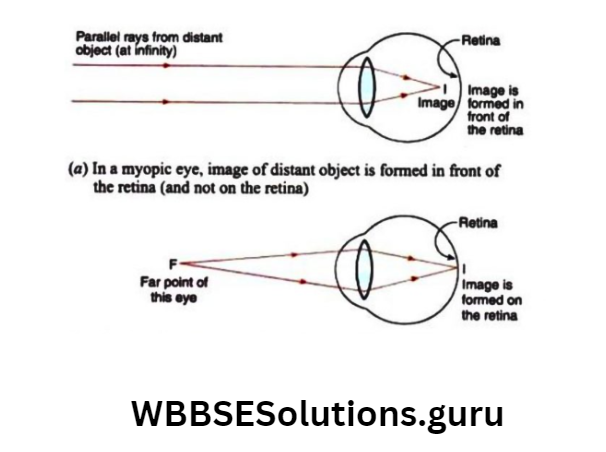
Defects of the human eye: Sometimes, the eye lens may lose its power of accommodation,
Such that the focus: and length of the eye lens cannot be adjusted as required for the formation of sharp images or the retina. This is called the defect of vision.
The major two types of defects of the human eye are myopia or short-sightedness or near-sightedness and hypermetropia or long-sightedness or far-sightedness.
Short-sightedness or myopia: A person who has myopia can see nearby objects clearly but cannot see distant objects distinctly.
The defect arises due to high converging power eye ens. shorter/compared to the normal eye and longer (enlarged) eye-ball so that in a myopic eye, the image of the distant object is not formed at the retina, but rather formed at a point in front of the retina.
This defect is usually seen in youths. That’s why, distant objects will appear blurry. So to see distant objects myopic eye needs spectacles.
Long-sightedness or hypermetropia: A person who has hypermetropia can see distant objects clearly but cannot see nearby objects distinctly.
That is, for the hypermetropic eye, the nearby objects like letters of books appear blurry whereas the writings on a distant board appear clear.
The defect arises due to the low converging power of the eye lens longer/compared to the normal eye and shorter eyeball so that the near point of the hypermetropic eye is more than 25 cm. Of course, defective near point for different people is different.
In a hypermetropic eye, the image of the nearby object is not formed on the ret but rather at a point slightly behind the retina.
So to see nearby objects clearly the persons need spectacles. The defect is mostly seen in old persons.
The defect of hypermetropia is corrected by using a convex lens of suitable focal The convex lens converges the light rays more to make them on the retina.
The convex lens should be of suitable power so that the lens can produce a virtual image of the nearby object on the near point of the hypermetropic eye.
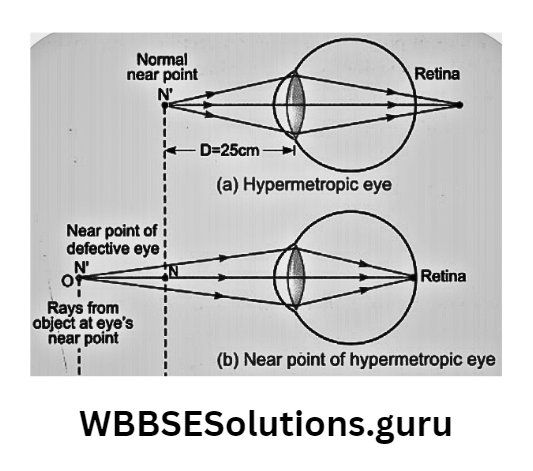
Now the person can see a clear image of the object. A student is unable to read the blackboard while sitting in the last row the defect is myopia.
The student has to use spectacles with positive power. A man suffering from hypermetropia uses spectacles with negative power.
A man may suffer from both myopia and hypermetropia. and he requires spectacles with bifocal lenses, the upper part of which is a concave lens to see distant objects and the lower part of it is a convex lens to see nearby objects distinctly.
Activity: Making a model of a camera.
Apparatus and materials: Hard interlocking rectangular boxes with one side open. These are designed such that they can fit with each other.
A magnifying glass is taken as a focusing lens. A piece of translucent plastic/paper or the tracing paper is taken on which the image can be focussed using the lens. Cellotape, gum, black cloth or paper, etc.
Different parts of a simple camera are Cut a hole in the front box. The hole would be equal to the diameter of the magnifying glass. Fix up the magnifying glass into the hole with sellotape.
The translucent paper is fitted at the back of the box with tape. The boxes are arranged such that the magnifying glass can be moved back and forth (the focussing mechanism of the simple camera).
A black cloth/paper is put over the camera to prevent external light to fall on the tracing paper.

With bifocal lenses, the upper part of which is a concave lens to see distant objects and the lower part of it is a convex lens to see nearby objects distinctly.
Point the camera towards the window. Moving the mobile part forward and backward focussing is done and one can see an upside-down image on the tracing paper. To take a photo, a film is to be placed at the end of the camera.
Chapter 5 Dispersion Of Light What Happens When White Light Passes Through A Prism?
Dispersion of light What happens when white light passes through a prism?
Dispersion of white light: Sir Isaac Newton first observed that when a narrow beam of white light is passed obliquely through a glass prism, the light is split up into seven different colors.
A colored patch is seen on a white screen placed on another side of the prism, which is called the spectrum The colors in the spectrum are arranged in a particular order.
From the top: Red, Orange, Yellow, Green, Blue, Indigo, and Violet. The sequence of colors Dispersion by a prism is VIBGYOR (taking the initial letters of each color).
One beautiful natural example of the dispersion of light is the rainbow where white sunlight is seen to be split into different colors.
Definition: The splitting of white light into its seven constituent colors while passing through a refracting medium (like a prism) is known as the dispersion of light.
The band of colors (VIBGYOR) obtained by the dispersion of light is called a spectrum.
Reason: Why a simple glass prism splits white light into different colors?
When light from the air enters into the glass, there happens bending of its path and once again when the light comes out from glass to air, bending of the path takes place.
As a whole, while passing through a prism, light is refracted toward the base of the prism. We learned that white light is made up of seven different colors. Also, different colors of light have the same speed in air (3 x 108 m/s).
But the moment, white light strikes the glass prism, the speed of different colors becomes different in the glass prism.
Red color has maximum speed and violet color has minimum speed. Because of the change in speed of different colors, they bend at different – angles in the glass prism.
The red light bends the least and the violet light bends the most. The speed of light is different for the light of different colors in a medium other than air or vacuum.
Wavelength (λ) means the length of one full wave. The speed of light increases with an increase in the wavelength of light.
For example, in visible light because violet red, as \(v_{\text {violet }}<v_{\text {red }} \text {, as } \mu=\frac{c}{v} \text {. So we get } \lambda_{\text {violet }}<\lambda_{\text {red }}\)So we get According to Snell’s law, different colors have different refractive indices in a glass prism.
Thus, for the same angle of incidence of white light, there are different angles of refraction and hence the angular deviation is different for different colors.
A beam of light is split up into seven colors when refracted through a glass prism, but not by a rectangular block of the same glass.
While passing through a rectangular glass block, the incident light and the emergent light become parallel to each other. So, there is no question of splitting.

Chapter 5 Light Idea Of Monochromatic and Polychromatic Light
In Greek, ‘mono’ means ‘one’ and ‘poly’ means ‘many’, and ‘chroma’ means ‘color’. Monochromatic light is light made of one (single) color, i.e., of a single wavelength.
Polychromatic light exhibits several (more than one) colors and contains more than one wavelength.
For example, each color of the rainbow is monochromatic in nature, but white light formed by mixing the seven colors of the rainbow is polychromatic in nature.
What is the role of the color of light on the appearance of the color of an object?
A white beam of light falling on a colored opaque object absorbs all the colors of white light except the one of its own color and reflects light of that particular color only.
For example—
A white beam of light incident on a red flower reflects only the red color of white light and absorbs all other colors. So that the flower appears red.
A white beam of light White color is not actually white—it consists of all seven colors (VIBGYOR).
Different colors of light have different wavelengths.
Black is not a color—when all colors of light are absorbed by an object, it looks black.
incident on a green leaf reflects only the green color of white light and absorbs all other colors. So that the leaf looks green.
A green appears black in red light. The leaf can reflect only the green color of white light and can absorb the red light so that no color is emerge out of the leaf illuminated by red light.
A blue glass appears blue as it. transmits only the blue color of white light and practically absorbs of all other colors.
If we look at the sun through one red glass and one blue glass keeping in contact with each other, the glass combination appears black.
The red glass only allows the red color of sunlight and absorbs other colors. The blue glass kept in contact with red glass absorbs the red color. So, no color emerges out of the glass combination.
Chapter 5 Light Wave What Kind Of Wave Is Light Wave?
Light is a form of energy. It is a wave. The phenomena of interference and diffraction of light prove the fact that light travels in a vacuum or air in the form of a wave.
Do you know that ordinary light is a transverse electromagnetic wave? Because light is associated with the vibrations of an electric field \((\vec{E})\) and magnetic field \((\vec{B})\) mutually perpendicular to the direction of its propagation.
The speed of light is maximum in a vacuum and is equal to (this value is considered a fundamental constant in the study of science). \(c=3 \times 10^8 \mathrm{~ms}^{-1}\)
Speed (c), frequency (f), and wavelength (λ) of electromagnetic waves are related as c=fλ (i)
Wavelength (measures the length of an individual wave and frequency (f) describes how many waves per second a wavelength produces.
The refractive index in terms of velocity: According to the wave theory of light, the absolute refractive index (μ) of a transparent medium can be expressed as the ratio of the speed of light in a vacuum to the speed of light in the medium
Thus, \(\mu=\frac{\text { Speed of light in vacuum (c) }}{\text { Speed of light in medium (v) }}\)
In general, the relative refractive index of medium 2 with respect to 1 medium (i2) can be expressed as:
\({ }_1 \mu_2=\frac{\mu_2}{\mu_1}=\frac{\text { Speed of light in medium } 1}{\text { Speed of light in medium } 2}=\frac{v_1}{v_2}\)These relations show that the amount by which a ray of light refracted depends on how much its speed changes.
The greater the change in speed, the greater the refractive index of the medium. O If 1 and 2 correspond to rarer and denser media, then,\(\mu_2>\mu_1 \Rightarrow{ }_1 \mu_2>1\)
v1>v2 So, when a ray of light passes from a rarer to a denser medium, the speed of light decreases.\(\mu_2>\mu_1 \Rightarrow{ }_1 \mu_2>1,\)
then \(\text { If }{ }_1 \mu_2<1 \Rightarrow \mu_2>\mu_1\) so when light passes from a denser to a rarer medium, the speed of light increases. if v1=v2 then, etc. So light enters into the second medium without any change in speed.

The refractive index in terms of wavelength: At the time of refraction, when light enters from medium 1 into medium 2, its frequency remains unchanged but speed and wavelength both are changed.
Suppose light causes sunburns μ1,μ2=1 Next comes X-rays which pass through soft tissues but not through bones or denser materials, y-rays produce even shorter X, higher /and more energy.
Its length is smaller than the size of an atomic nucleus.] lie f medium 1 and 2 respectively.
If X and X denote the wavelength and or the frequency of light of definite color, in a vacuum, and in any other transparent medium, then we can write, λ0 and λ denote the wavelength and f the frequency of light of definite color, in a vacuum and in any other transparent medium, then we can write,
\(\text { Refractive index; } \left.\mu=\frac{\mu_2}{\mu_1}=\frac{c}{v}=\frac{f \lambda_0}{f \lambda}=\frac{\lambda_0{ }^*}{\lambda} \text { As } c=f \lambda_0 \text {, and } v=f \lambda\right]\)That is The refractive index is inversely proportional to the wavelength of light. since
\(\lambda_{\text {red }}>\lambda_{\text {violet }} \text { so } \mu_{\text {violet }}>\mu_{\text {red }}\)Electromagnetic waves and Electromagnetic spectrum: Do you believe that we are always surrounded by different kinds of electromagnetic waves such as waves transmitted by radio, TV stations, waves emitted from Wi-Fi equipment, computers, phones, microwave ovens, visible light from the sun, and other stars?
Scientists described electromagnetic waves on the basis of their wavelengths (λ) or frequency (f), and the pattern is called the electromagnetic spectrum At one end of this pattern lies radio waves and y-rays at the other end.
Radio waves have the longest (nearly the length of a football ground or more) and the lowest / in the spectrum.
After radio waves lie microwaves which have shorter X and higher f—microwave ovens, phones, and readers use them. Next comes IR light.
We cannot see this part. We feel it as heat. Visible light occupies a narrow slice in the spectrum lying between IR light and UV light.
\(\lambda_{\text {red }} \rightarrow \text { largest, } \lambda_{\text {violet }} \rightarrow \text { lowest. }\)As we move from red light to violet light, X decreases and/or increases. Next comes UV light.
Skin produces vitamin D when exposed to UV light, but excessive Uv Light causes sunburns.
Next UV light causes sunburns. Next comes X-rays—which pass through soft tissues but not through bones or denser materials, γ-rays produce even shorter λ, higher and more energy. Its length is smaller than the size of an atomic nucleus
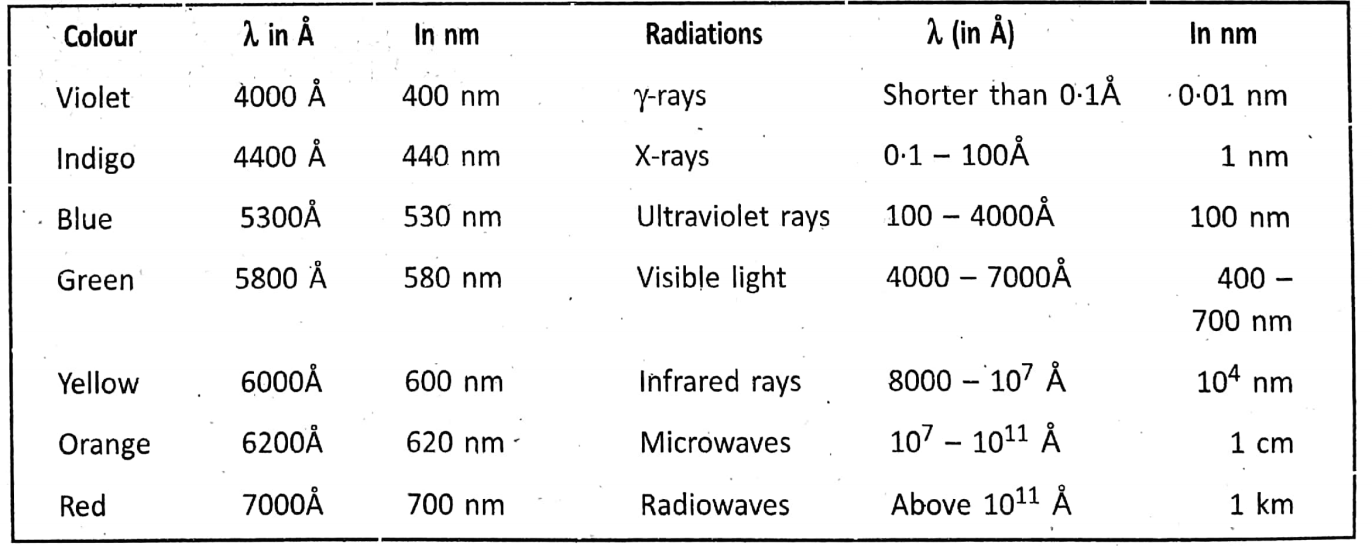
Chapter 5 Light Scattering Of Light
Scattering of light is a phenomenon of change in the direction of propagation of light waves caused by striking different atmospheric particles like dust particles, huge no of air molecules (mainly N2 and O2 molecules), and so on, of size smaller than the wavelength of visible light.
Sunlight consists of seven different colors of light having different wavelengths. When sunlight enters the atmosphere, the air molecules (size < 0.4 nm) scatter different colors differently. Scientist Rayleigh was the first to explain the scattering of light.
Rayleigh established mathematically that the intensity of scattered light is inversely proportional to the fourth power of the wavelength of the incident light Scatterme Thus, shorter wavelengths are more scattered than longer wavelengths.
Blue color has the smallest A, so the blue color is scattered the most, and red has the largest A, which is scattered the least.
So, whenever we look up at the sky, we see blue color. This is the fact why the sky appears blue.
If the earth had no atmosphere, there would be no question of scattering of light. The sky would then appear dark (as an astronaut sees the sky from outer space).
